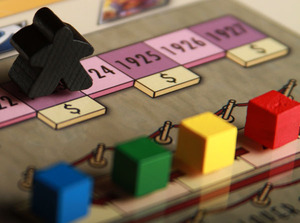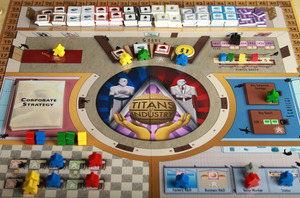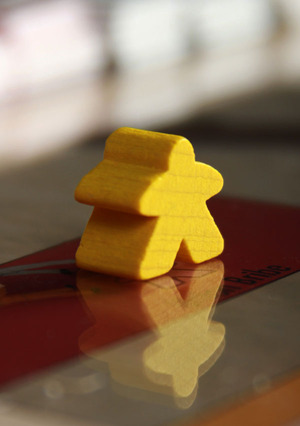My Experience With Geek Chic - Part 2
 Sunday, May 6, 2012 at 05:30PM
Sunday, May 6, 2012 at 05:30PM 
Several months ago I wrote about my initial experiences ordering a Geek Chic Emissary table. I promised a follow-up when it arrived, but I decided to wait a bit longer (which turned into a lot longer) before writing about the table so that I could give a better impression of what it's like to live with one. I've had my Emissary now for a little over 8 months, and while I love the table and I'm certainly glad I made the purchase, there are definitely some quirks that only become apparent after spending some time with it in the family.
The Table:
The table I purchased was a Walnut Emissary with a 6' x 4' play area and a bamboo vault surface with a plexiglass layer. I chose to forgo drawers in the table and opted instead for the rail system that allows accessories to latch onto the sides of the table. My main reason for this choice was that I play mostly board games and don't have much need for the accoutrements required for Role Playing Games.
The actual delivery of the table was scheduled about a week before the delivery date, and was set up by two friendly Geek Chic employees. Setup took less than 30 minutes, and was a fairly painless process. The fact that my game room is easily accessible helped. Someone with a narrow staircase, or tight turns in their hallways could potentially run into some issues due to the depth of the tabletop. After the table was assembled, I was told about its care and feeding and how to transform it into various configurations.
The table itself is well built, sturdy, and looks very sleek. The grain of the wood is almost iridescent, and reflects light differently from different angles - a very pretty effect that none of my simulated wood grain or veneer furniture possesses. Since walnut has different shades of color depending on where in the tree it comes from, the table has a lot of character.
After the table was assembled, we discovered that it was missing a couple of brass pins that belonged to a removable support structure that kept the table leaves from sagging. Since 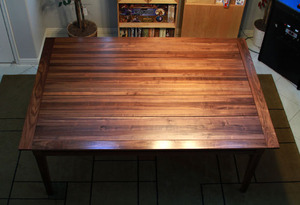 these pins weren't critical, Geek Chic had them mailed to me a few days later, which was a painless process. However, I also found that one of the leaves in my table was not lying flush with the surface of the table, and it appeared to be slightly warped. I was told that wood was malleable and would flex and change, and to invert the leaf and let gravity help get it back into shape.
these pins weren't critical, Geek Chic had them mailed to me a few days later, which was a painless process. However, I also found that one of the leaves in my table was not lying flush with the surface of the table, and it appeared to be slightly warped. I was told that wood was malleable and would flex and change, and to invert the leaf and let gravity help get it back into shape.
I was not 100% thrilled with this suggestion. After all, I had just paid $4000+ for a brand new table, and it seemed to have a flaw, but I took the advice and flipped the leaf. After a few months it wasn't warping as much, but it still wasn't lying flat, so I called Geek Chic and they agreed to replace the leaf when they had another delivery in my neck of the woods.
About 2 months later my new leaf was delivered, and it fit perfectly into place. This new leaf is a slightly different color than the others, but it was explained that the wood changes color as it ages, and since the rest of the wood in my table is 8 months older than the new leaf, it will take time for it to catch up. I'm sure the colors will mesh better as the table ages (even in the past few weeks i have seen a difference in the color of the leaf), but it still makes me a bit nervous and I wish that the issue was addressed by Geek Chic earlier in the process. (If it looks like one leaf is slightly off-color in the photos, that is why - it is not indicative of how the table arrived.) All in all though, it was a positive experience, and I'm sure if I had been adamant that the leaf be replaced earlier, Geek Chic would have accommodated me.
Rail System - Instead of drawers, I chose the rail system for my table. The rail system is a groove that extends along the side of the table, onto which different accessories can be attached. The only accessories I purchased were cup holders, but I can see myself ordering a few desk or bin attachments in the near future.
Because the rail is just a groove in the wood of the table, it can't support a lot of weight. This makes it perfect for cup holders, or other small accessories, but care would have to be taken with a desk or any other accessory that someone might be tempted to lean on. In fact, since the cup holders extend past the edge of the table when inserted into the groove, I've had a couple of close calls with people bumping into them with their legs while standing up, or walking past. This doesn't make them non-functional, it just means people need to take care when moving around the rail accessories.
Rail accessories come in two types: locking and non-locking. Locking accessories have a little latch that has to be pulled in order to remove them, or slide them along the rail, whereas the non-locking accessories do not. I chose the locking cup holders, and have found them to be very functional.
not. I chose the locking cup holders, and have found them to be very functional.
In what is a bit of a trend with the accessories for the Emissary, it is important to have a place to store the cupholders. While the wooden brackets can be stored in the closed table, the metal part of the cupholder is too tall to fit in the table vault, and will have to be stored elsewhere.
Table Vault - The coolest part of the Geek Chic Emissary table is the "Vault". This is a recess in the table where games can be left in-play, and then covered with the hardwood leaves. Since there are several inches between the surface of the vault, and where the leaves slide in, the game can be kept in stasis under the leaves, while the tabletop is used for other normal table-like activities (or another game!).
It's important to note that the leaves do not fit together tightly enough to make a waterproof seal. If you plan on using the table for dinner, I would definitely suggest using a tablecloth with a waterproof liner. A  spilled drink would still leak into the vault and cause all sorts of destruction. I don't actually eat at the table, so spills aren't too much of an issue for me, but the kids often do their homework on it, and so I will often find a million little eraser shavings in the vault when I open it. While the Emissary is very effective at its dual purposes, little things like that can be frustrating and being preventative can go a long way to restoring sanity.
spilled drink would still leak into the vault and cause all sorts of destruction. I don't actually eat at the table, so spills aren't too much of an issue for me, but the kids often do their homework on it, and so I will often find a million little eraser shavings in the vault when I open it. While the Emissary is very effective at its dual purposes, little things like that can be frustrating and being preventative can go a long way to restoring sanity.
The vault also has the option for a plexiglass sheet that fits over its surface. This is really nice for multiple reasons. First of all, it can be written on with wet or dry erase markers. This may be more of a feature for the RPG gamer than the board gamer, but it's still really neat. Second, people who enjoy playing games that use paper maps or boards will find that putting them under the plexiglass will keep them flat. I've found this incredibly useful when doing reviews, and taking photos of wargames and print & play prototypes.
incredibly useful when doing reviews, and taking photos of wargames and print & play prototypes.
The plexiglass will have to be removed from time to time and cleaned. It is inevitable that little pieces of dirt and dust will find their way between the plexi and the vault surface. Geek Chic includes a cool suction tool to remove the plexi (It looks like something James Bond would use when he's cutting a hole in an alarmed glass case), although moving a 6' x 4' piece of plexiglass is still quite  a task.
a task.
Leaves -The 5 leaves that cover the table vault are all made of solid hardwood. They look really nice, but are surprisingly heavy, and need to be stored somewhere when the vault is in use. I usually just set them up against the wall (although if warping is a concern, or the vault is going to be open for an extended period of time, they are probably best laid flat on the floor.) They can be somewhat cumbersome to move, as well. When looking at the pictures, it's sometimes hard to remember that each leaf is 6 feet tall.
an extended period of time, they are probably best laid flat on the floor.) They can be somewhat cumbersome to move, as well. When looking at the pictures, it's sometimes hard to remember that each leaf is 6 feet tall.
I especially like that the leaves can be arranged in different configurations. When all five are on the table, it's a typical wooden tabletop. When all the leaves are removed, the entire vault area is available. My favorite configuration, however, is when two leaves are left on the table as "desks", and a portion of the vault is left visible.
This separates a player's personal play-space from the common play-space. Reaching things in the center of the table can sometimes be a bit difficult from a sitting position, but in this configuration, players can keep all of their pieces and player boards close to them, and only 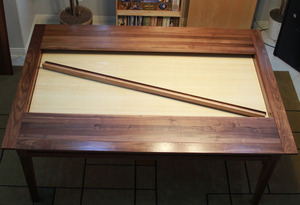 need to reach when interacting with the main board (plus it just looks cool).
need to reach when interacting with the main board (plus it just looks cool).
Now, simply leaving two leaves in could cause issues, because pieces could accidentally get pushed under a leaf, or a player could lean against the leaf and push it forward, spilling their components into the vault. But, luckily Geek Chic has a solution to this with two long wooden pieces that fit into the leaves to close the gap and stabilize the leaves.
If a player leans against the "desk" that is made from a leaf, it is still possible to push the guard out of place, and cause the leaf to slide forward (I tend to do this rather frequently because I'm an "elbows on the table" type person), but it does keep the leaf much more stable, as well as making the table more attractive in this configuration.
Since the Emissary is in "Normal Table" mode most of the time, the 6 foot leaves can tend to sag in the middle. Geek Chic combats this problem through the use of a wooden bar that slides into the center of the table on two brass pins, when the vault is not in use. This keeps the leaves supported in the center, and helps them keep their shape.
wooden bar that slides into the center of the table on two brass pins, when the vault is not in use. This keeps the leaves supported in the center, and helps them keep their shape.
There is a bit of a storage issue with the cross-bar support and the leaf "desk" stabilizers. The stabilizers can be stored in the vault when not in use, but only if the cross-bar support isn't installed. This means that someone who has both has to make a decision between safety of the leaves or storage convenience. It's not too hard to find a place to store the stabilizers; they are long, but not bulky, so fit easily into a closet. However, it would have been nice if there were some sort of integrated storage solution to keep all of the parts of the table together when it was closed.
I am very happy with my purchase. Aside from a couple of hiccups with a missing part and a warped leaf, the purchase experience was great. I'm very happy with my table; it's well built, and looks great. In fact, the Emissary is probably going to be the driving force in upgrading the other furniture in my game room, because everything else looks cheap in comparison.
The only big issue I have with the table is one of storage. The cupholders cannot be stored in the table and the leaf shelf supports cannot be stored in the table while the crossbar support is in use. Since I don't want my leaves to warp, it means I have to store the long shelf supports in the closet. It would have been really helpful if the Emissary had some sort of rack or a set of hooks on the bottom of the table to store these pieces along with the table.
All in all, I'm very happy with my purchase, and plan to enjoy my Emissary for years to come. In fact, I'm already counting my money trying to find a way to get one of the smaller coffee table sized pieces into my living room. If you are in the market for quality furniture that will fit your gaming needs, as well as go incognito as a normal kitchen table, the Emissary is just the ticket.
 Gaming Furniture,
Gaming Furniture,  Geek Chic,
Geek Chic,  emissary,
emissary,  furniture,
furniture,  gaming table,
gaming table,  review in
review in  Board Games
Board Games 







